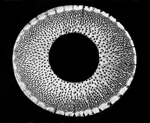
"MU-KU-TEKI SUIZEN"
No-hole Flute Blowing Meditation
Calligraphy signed by Myōan Taizan
In T.O.'s collection

"MYŌ-AN"
The Duality of the Clear
and the Obscure
By Tanikita Muchiku, 1875-1957

"MIND-MOON-CIRCLE"
Calligraphy by Ryōkan
18th or early 19th century
(shown in negative)
|
Chronology
JAPAN 8 • 1883 ...
Cordial thanks to Taguchi Shigeo (excellent interpreter & translator) & Kirsten Refsing (PhD, Professor Emerita), Denmark,
for assisting me with the translation and interpretation of essential texts presented on this webpage,
related to the Myōan Taizan-ha tradition of "Ascetic Shakuhachi Practice".
THE REORGANIZATION and CONTINUATION of ASCETIC SHAKUHACHI PRACTICES in JAPAN
1883: The 1871 government ban on religious mendicancy is lifted.
明暗協会 - MYŌAN KYŌKAI
明暗対山派本曲 - MYŌAN TAIZAN-HA HONKYOKU
1890 - THE MYŌAN SOCIETY is FOUNDED
In July, 1890 (Meiji 23), a new shakuhachi society, the Myōan kyōkai,
明暗教会,
was established - with the purpose of the preservation and continued practice of original Komusō Shakuhachi music.
A comprehensive repertory of carefully chosen shakuhachi pieces, the socalled honkyoku, had been compiled by Higuchi Taizan, 1856-1914,
who became the first head instructor of a new line of ascetic shakuhachi practice, the Myōan Taizan-ha,
明暗対山派,
According to Machida Kashō, 1956, p. 375, however, the information is given somewhat differently,
"The Fuke sect had been outlawed in 1871, and the following year the regimen of the mendicant had been proscribed.
This led to great difficulties in the propagation of Buddhism, however, and in 1878 the various sects jointly petitioned the government for permission to revive mendicancy.
In 1881 the request was granted by the Ministry of the Interior.
In 1883 the Meian Kyōkai (Meian Society) was founded with Prince Kujō as its head,
its purpose being to preserve the komusō system, even if The Fuke Sect itself could not be revived. - - - "
明暗寺三十五世 樋口対山
MYŌAN-JI SANJŪGO-SE HIGUCHI TAIZAN

Higuchi Taizan - 1856-1914

Chōshi, calligraphed by Higuchi Taizan
A treasure of the Higuchi Family
In: Ikeda Juzan shū. Taizan-fu shūi, 1985, p. 62
1896:
中尾都山 -
都山流
NAKAO TOZAN founds the Tozan-ryū of shakuhachi in Ōsaka

Nakao Tozan, 1876-1956
Source: Komuso.com: Nakao Tozan
20th CENTURY
1930:
小林紫山
&
富森虚山
Kobayashi Shizan and Tomimori Kyozan introduce the expression,
that particular term - that very "idea" ...
'SUI-SHŌ-ZEN'
吹簫禅
"BLOW-FLUTE-MEDITATION"
1930s

Okabe Village: Two komusō walking in the Snow
Tanzaku print, 1930s, by Takahashi Shōtei, 1871-1945
Sources: www.degener.com & www.shotei.com
明暗寺三十七世 谷北無竹
MYŌAN-JI SANJŪNANA-SE TANIKITA MUCHIKU

Tanikita Muchiku - 1878-1957
1940s?

'MYŌAN SŌ BŌ'
"Bright-Dark Pair Forget"
Calligraphy in honkyoku ori-hon dated 1941? (Shōwa 16?)
by Tanikita Rōan Muchiku, 1878-1957
Reproduced in Inagaki, 1981

'CHŌ TAN HAKU-UN KŌ - SHŌ TETSU HEKI TAN SHIN
調干白雲高、聲徹碧潭深。
"The Music drinks of the Eminence of White Clouds;
The Voice permeates the Profundity of Blue Water in the Deep"
Chinese poem in honkyoku ori-hon dated 1941? (Shōwa 16?)
by Tanikita Rōan Muchiku, 1878-1957
in praise of a famous poem by Fuke Zenji's
master Banzan Hōshaku, 720-814
Reproduced in Inagaki, 1981
Trsl. by Torsten Olafsson, 2010
1950-1953:
吹禅 - SUIZEN
"Blowing a Flute Ascetic Non-dualistic Contemplation Practice"
This very new term was most certainly invented and introduced into modern ascetic shakuhachi ideology by Yasuda Tenzan,
安田天山,
1909-1994, while he was acting as the first head monk of the modern Myōan Temple during the years 1950 to 1953.
On Saturday August 8, 2009, US citizen Dean Seicho Delbene posted this illustration on his Myoan Shakuhachi Blogspot Website:

Tomimori Kyozan's Statement regarding the origin of the terms suizen/suishōzen, no date
Link to webpage: http://myoanshakuhachi.blogspot.com/search?updated-max=2009-08-26T17:16:00-05:00
Please also visit this related webpage to learn more about the origin of the term 'Suizen':
1950s ... : The Origin of 'Suizen' at Kyōto Myōan-ji:
Kobayashi Shizan, Tomimori Kyozan,
Tanikita Muchiku, Yasuda Tenzan,
Hirazumi Taizan, Koizumi Ryōan,
Fukumoto Kyoan, Yoshimura Sōshin a.o.
宗教法人普化正宗明暗寺 - SHŪKYŌ-HŌJIN FUKE SHŌSHŪ MYŌAN-JI
1950, March (or 1959?): "The Religious Institution Temple of Light and Darkness of the True Fuke Sect",
Shūkyō-hōjin Fuke Shōshū Myōan-ji,
is established and opened in the Zen'e-in,
善慧院,
a small subtemple of Tōfuku-ji, SE Kyōto, as the official head temple
of all modern Komusō/Fuke Shakuhachi branches in Japan.
Do note that Dean DelBene gives the year 1950 *, whereas the founding year being stated on the Myōan Temple's own website is 1959!
That, however, appears to be a typo, as the characters '9' and '0' are "neighbours on the keyboard. **
Yet, at the KyotoFukoh.jp website the year is given as 1950. ***
* Link, see the last paragraph on webpage: http://myoanshakuhachi.blogspot.com/2017/03/a-brief-history-of-fuke-sect-and-myoan.html -
** Link, see section 1, paragraph 3, lines 3-5: http://myouan-doushukai.org/komuso.html
*** Link, see: https://kyotofukoh.jp/report1542.html

The gate of Kyōto Myōan-ji, the signboard reading
"Myōan-ji - Fundamental Spiritual Training Center for the Shakuhachi".
Photo by Torsten Olafsson, 1977
Early 1950s: A "'Suizen' 'Takuhatsu' Begging Practice Credo"
Certainly not before 1950, various Suizen gyōka-shō,
吹禅行化証,
or "Ascetic Shakuhachi Certificates of Conduct", were issued by the Myōan Temple in Kyōto
replacing the former Komusō gyōka-shō
虚無僧行化証, 'Komusō Certificates of Conduct",
of the latter part of the Edo Period.
Do note, that acc. to the present Myōan Dōshu-kai website,
the term/expression 'Gyō-ka', or 'Gyō-ke',
行化,
is directly synonymous with 'Taku-hatsu',
托鉢,
namely "religious begging":
Since the 1950s, when the modern Myōan Temple 'komusō' was practicing religious begging,
his shakuhachi playing in return for alms received
would have the purpose described in this "credo", see translation below.
Link to webpage, see line 5 from page bottom: http://myouan-doushukai.org/komuso.html

'Suizen gyōka seigan-bun', or 'Suizen gyōke seigan-mon',
吹禅行化誓願文,
"Ascetic Shakuhachi Begging Practice Oath."
Precise date unknown.
The 'Suizen' Text Reads and Translates as follows:
吹禅行化誓願文
'Suizen gyōka seigan-bun'/'Suizen gyōke seigan-mon'
"'Suizen' Practice Pledge" - which is in fact rather a "'Suizen' Practice Credo"
一吹
為断一切悪
いっすい
いだん いっさい あく
'Issui i-dan issai aku'
"The first breath cuts away All Evil"
二吹
為修一切善
にすい
いしゅ いっさい ぜん
'Nisui isshū issai zen'
"The second breath leads towards All Goodness"
三吹
為度諸衆生
さんすい
いど しょ しゅう じょう
'Sansui ido sho shū jō'
"The third breath benefits Mankind and All Livings Things"
皆共成仏道
かいぐ じょうぶつ どう
'Kaigu jōbutsu dō'
"The Way for Everyone to Attain Buddhahood"
嘘霊山明暗寺
'Kyoreizan Myōan-ji'
"Non-dual Spirit Mountain Myōan-ji"
The source of the above given information, it should be noted, is the website of the Kyōto Myōan Temple named Myōan dōshukai,
明暗導主会:
myouan-doushukai.org
Please visit this related webpage to learn more about the origin of the term 'Suizen':
1950s ... : The Origin of 'Suizen' at Kyōto Myōan-ji:
Kobayashi Shizan, Tomimori Kyozan,
Tanikita Muchiku, Yasuda Tenzan,
Hirazumi Taizan, Koizumi Ryōan,
Fukumoto Kyoan, Yoshimura Sōshin a.o.
See also this related individual webpage:
1950s: A Modern 'Komusō' 'Suizen' 'Takuhatsu' Credo
1960:
浦本浙潮 - URAMOTO SETCHŌ
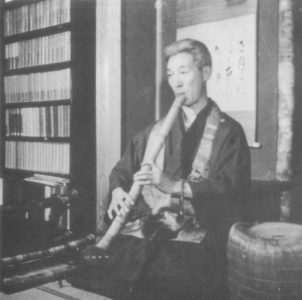
Uramoto Setchō, 1891-1965
Link to source: Uramoto Setchō commemoration webpage
普化尺八: 行
の
音楽
FUKE SHAKUHACHI: GYŌ no ONGAKU: MUSIC of ASCETICISM
「普化尺八は行の音楽であった。
尺八は心で吹くな 手で吹くな
寒夜に霜の降るごとく吹け -
総てが自然であり、殊更なる意識なく、
まして況んや技巧をや。
混沌として未分、只精進に因 って
s
のみ向上する。
若し人間も措いて尺八だけがうまいといふ人があるならば、それは人間と尺八との分離である、
混沌未分ではなくして病的分離の症状に過ぐ ぎぬ。」
"Fuke Shakuhachi was (is) the music of asceticism [gyō no ongaku].
Playing shakuhachi, you blow with your mind, blow with your fingers, like when frost comes down in the shivering cold night.
As a whole, it is "Self" / "Nature" [shizen] without any deliberate consciousness.
Not to mention, let alone any technique, nor finesse [gikō].
Being unresolved in confusion, simply practicing asceticism will nothing but bring about elevation [alt.: improvement, advancement, progress].
Supposingly, when there are people who say that there are also human beings to whom the shakuhachi is only "delicious" [umai]
... that is to detach human beings from the shakuhachi.
Doing away with unresolved confusion, that brings an end to the symptoms of abnormal detachment."
Quotation from Uramoto Setchō's essay 'Zen mondō to satori.'
Essay originally published by Shunjūsha, 1960, 12 pages.
Source of quotation and info: Kikkawa Eishi, 1975, pp. 55-56.
Quotation translated by Torsten Olafsson, 2018.
池田壽山 - IKEDA JUZAN

Ikeda Juzan - 1888-1976
In: Ikeda Juzan shū, 1985
1960:

Shakuhachi and 'Ichion jōbutsu' calligraphy
Sumi-e dated 1960 (Shōwa 35) by Ikeda Juzan, 1888-1976,
a prominent student of Higuchi Taizan
Reproduced in Ikeda Juzan shū, 1985
1966:
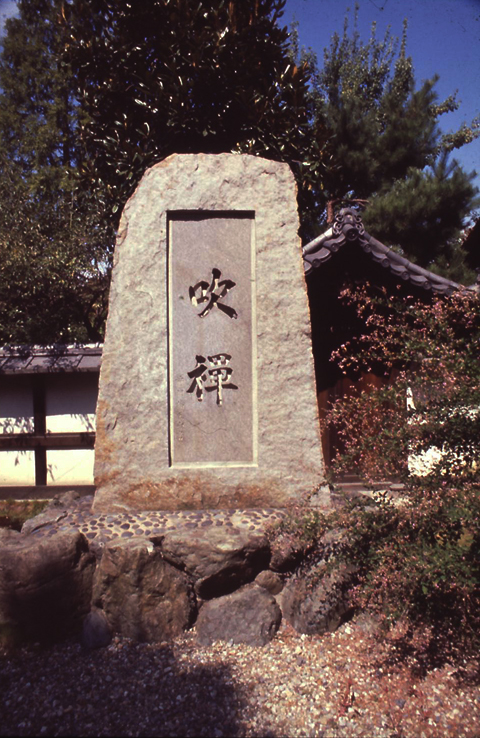
Famous 'Suizen' monument erected in 1966, at the Myōan Temple in Kyōto.
Photo by Torsten Olafsson, early Spring, 1977.
1969:
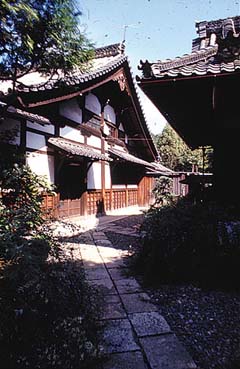
Kyōto Myōan-ji, Main Hall completed in 1969
Photo by Torsten Olafsson, 1977
禅尺八 - 'ZEN SHAKUHACHI'
修養の尺八 - 'SHŪYŌ no SHAKUHACHI'
"The Shakuhachi of Self-cultivation and Self-discipline"
明暗寺四十世 芳村普庵宗心
MYŌAN-JI YONJŪ-SE YOSHIMURA FUAN SŌSHIN
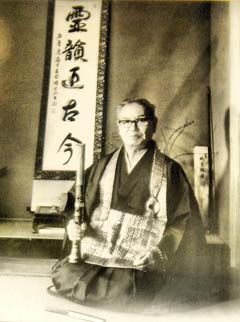
Yoshimura Fuan Sōshin - 1904-06-27 to 1998-10-21
1977 - YOSHIMURA FUAN SŌSHIN
此れは明暗尺八吹奏と言ふ物でわ有りません。
決定された吹奏法と言ふ物は御在いません。
唯、私の言えまするは素直な心で、
唯、一心に吹くるが私の心です。
技功を弄して、上手に吹くとか、
大いにならして、人に聞かせ様等
と言ふ我の心を持って吹くるは
一番悪い人間の心だと
私は考えて居ります。
技功によって変わった音を出す人も有りますが、
明暗寺尺八吹奏は自分の心に音を聞かせて
自分がその音によって、心を修めるるが
私の禅尺八の有り方と考えて居ります。
なかなか言葉では表現出来ませんが、
つまり禅尺八としての尺八は唯々
心を素直に持って, 我の心による
技功に成らない様、修養の尺八です。
此の修養の毎日の積み重ねが
自分と言ふ人間の心に成ります。
何るも、自然にさからうるは悪いるです。
自然に副って、道をあやまらぬ様にと
私は日々心がけて居ります。
"Myōan Shakuhachi can not be likened to the playing of an ordinary wind instrument.
Such thing as a fixed way of playing does not exist.
What I can say is, plainly, that I am only concerned with directing my blowing towards my own Self - with a gentle mind."
It is my opinion that people who trifle with skill of playing and "play well" - who exercise exceedingly intending to impress the listener and the like -
that way of blowing with an egocentric mind represents the worst of human attitudes (that I can think of).
There are people who can produce changing sounds depending on technical skill, but as for the shakuhachi practice of the Myōan Temple,
I believe that the ideal way of Zen Shakuhachi is to let one's true Mind listen to the sounds and to cultivate one's own Self in accordance with those sounds.
I can not easily express this in words but to practice the shakuhachi of Zen Shakuhachi is indeed a way of mental training and self-cultivation that is practiced
with an open and humble mind and does not develop into (mere) technical skill with a selfish attitude.
The accumulation of this daily practice will, eventually, bring about the realization of the true Self of one's Human Nature.
It is, in any case, wrong to act against Nature.
I am devoting myself every day to follow Nature and not to be mistaken about the Way."
Yoshimura Fuan Sōshin, Myōan-ji, August 9, 1977.
Private correspondance. Trsl. by Torsten Olafsson
明暗尺八 - MYŌAN SHAKUHACHI
明暗雙雙 - MYŌAN SŌSŌ - "The Myōan Pair"
法器 - HŌKI - "Instrument of the Buddhist Law"
小沢盛山
1978 - OZAWA SEIZAN
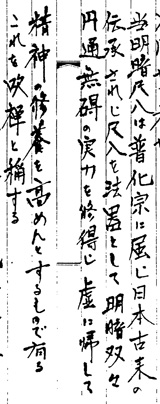
Detail of a letter of recommendation for T.O.
written by Ozawa Seizan in Spring, 1978
See translation below ...
当明暗尺八は、普化宗に属じ日本古耒の伝承されじ
尺八お法器として、明暗双々円通無碍の実力を修得じ、虚に帰して、精神の修養を高めんとするしので有る。
これを吹禅と稱する。
"Myōan Shakuhachi is related to the Fuke Sect of Shakuhachi and it has as its purpose to employ the ancient Japanese shakuhachi flute as a Dharma instrument [hō-ki]
in order that one understands the Ultimately Adual Nature of the 'Clear' and the 'Un-clear' [Myō-An] and experiences the Essence of Non-substantiality [kyo]
through self-cultivation.
This practice is called Suizen."
By Ozawa Seizan, 1939-2012, Myōan-ji, 1978, in a letter
of recommendation to the author. Trsl. by Torsten Olafsson.
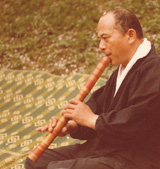
Ozawa Seizan Sensei, 1939-2012 - Spring, 1978
Not later than Early Spring, 1978


'MU-KU-TEKI SUI-ZEN'
"No Hole Flute - Blow Ascetic Non-dual(istic) Practice"
Calligraphy signed 'Myōan Taizan', the 2nd present times
Myōan Temple chief monk Hirazumi Taizan,
平住台山,
(a.k.a. Myōan Taizan),
inaugurated in 1952, died in 1984 (Shōwa 59).
Signature and stamps deciphered by Kosuge Daisetsu (Komusō kenkyūkai/Hosshin-ji),
and Sato Nakazato, Japan. A present to Torsten Olafsson
given by his teacher Ozawa Seizan in Summer, 1978
1985
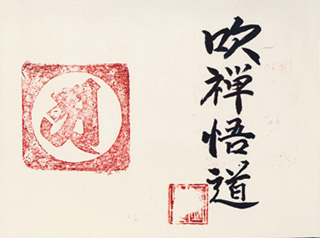
Opening pages of a honkyoku folding book (ori-hon)
written by Matsumoto Kyozan,
松本虚三,
dated 1985.
To the right: 'Suizen godō':
"Suizen Way of Buddhist Enlightenment".
To the left the Sanskrit seed syllable 'A' (Jap.: 'A')
of the Buddha Mahāvairocana, or
Dainichi Nyorai, residing in the center of the
Taizō-kai (Womb Realm) mandala (Skt.: Garbhadātu)
of Japanese Tantric Buddhism (Shingon)
Trsl. by Torsten Olafsson
2005:
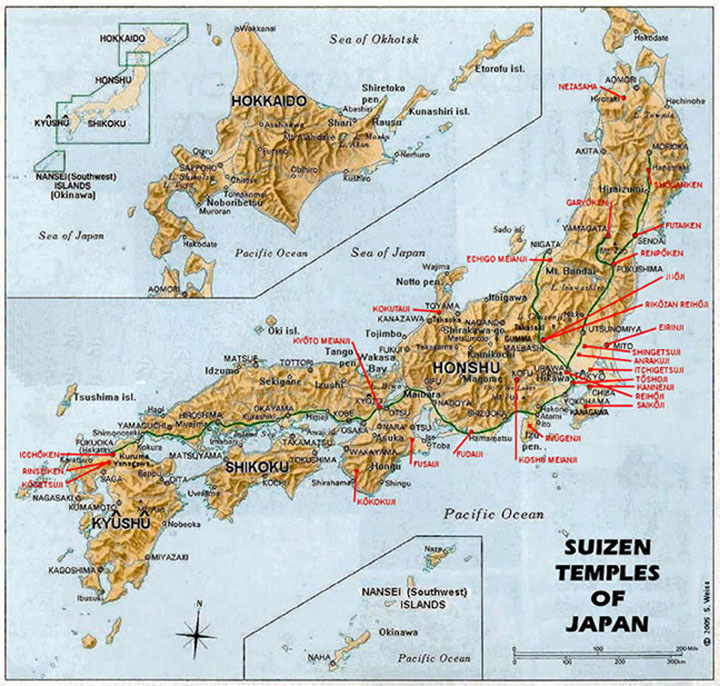
Map of 26 "'Suizen' temples" - during the late Tokugawa Period, really?
Compiled by Steve Weiss, 2005, approved by Kurahashi Yoshio.
Source: www.shakuhachi.com
There were, of course, no such "'suizen' temples" mentioned anywhere, nor ever,
in Edo Period documents, whatsoever!
|
|
